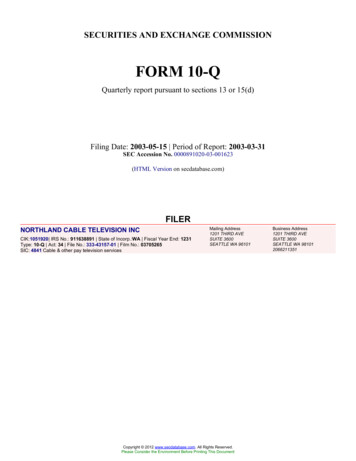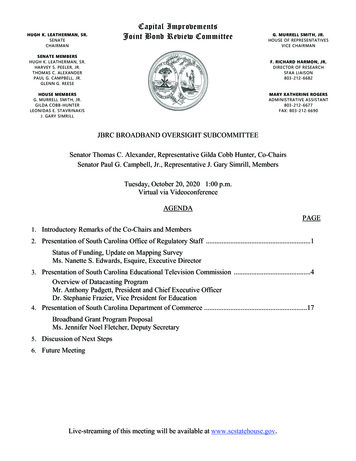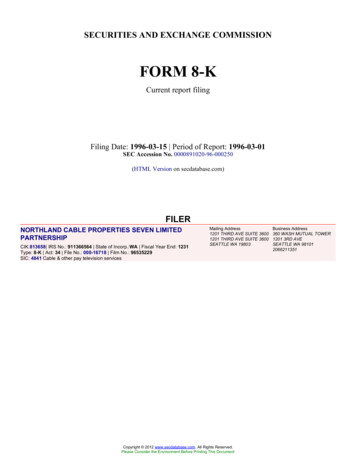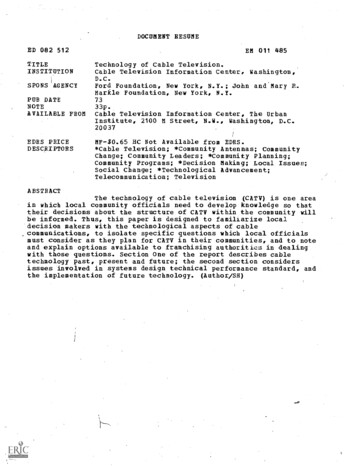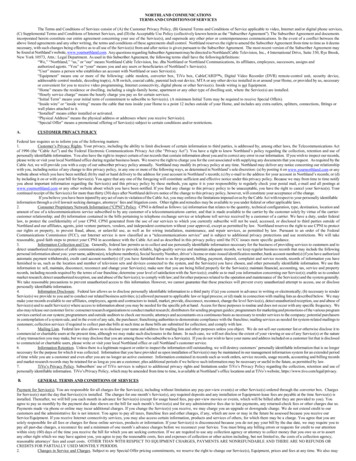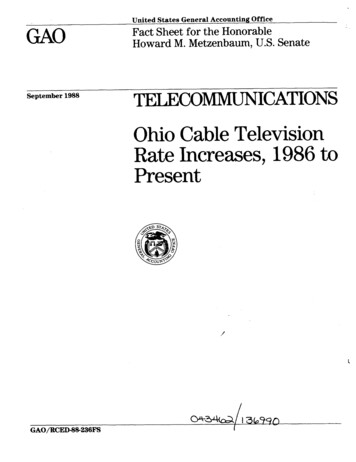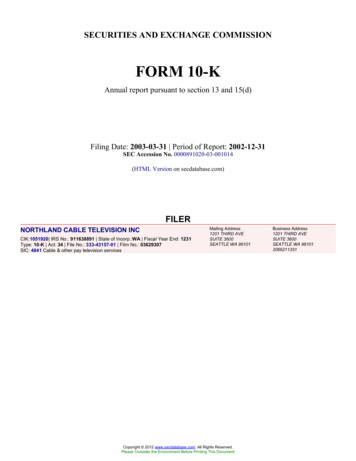
Transcription
SECURITIES AND EXCHANGE COMMISSIONFORM 10-KAnnual report pursuant to section 13 and 15(d)Filing Date: 2003-03-31 Period of Report: 2002-12-31SEC Accession No. 0000891020-03-001014(HTML Version on secdatabase.com)FILERNORTHLAND CABLE TELEVISION INCCIK:1051920 IRS No.: 911638891 State of Incorp.:WA Fiscal Year End: 1231Type: 10-K Act: 34 File No.: 333-43157-01 Film No.: 03629307SIC: 4841 Cable & other pay television servicesMailing Address1201 THIRD AVESUITE 3600SEATTLE WA 96101Copyright 2012 www.secdatabase.com. All Rights Reserved.Please Consider the Environment Before Printing This DocumentBusiness Address1201 THIRD AVESUITE 3600SEATTLE WA 981012066211351
Copyright 2012 www.secdatabase.com. All Rights Reserved.Please Consider the Environment Before Printing This Document
Table of ContentsFORM 10-K ANNUAL REPORT PURSUANT TO SECTION 13 OR15(d) OF THE SECURITIES EXCHANGE ACT OF 1934(As last amended in Rel. No. 34-29354 eff. 7-1-91)UNITED STATESSECURITIES AND EXCHANGE COMMISSIONWashington, D.C. 20549FORM 10-K[X]ANNUAL REPORT PURSUANT TO SECTION 13 OR 15(d) OF THE SECURITIESEXCHANGE ACT OF 1934 [FEE REQUIRED]For the fiscal year ended DECEMBER 31, 2002[ ]TRANSITION REPORT PURSUANT TO SECTION 13 OR 15(d) OF THE SECURITIESEXCHANGE ACT OF 1934 [FEE REQUIRED]For the transition period fromtoCommission file number 333-43157NORTHLAND CABLE TELEVISION, INC.(Exact name of registrant as specified in its charter)STATE OF WASHINGTON91-1311836(State or other jurisdiction of incorporation or organization(I.R.S. Employer Identification No.)AND SUBSIDIARY GUARANTOR:NORTHLAND CABLE NEWS, INC.(Exact name of registrant as specified in its charter)STATE OF WASHINGTON91-1638891(State or other jurisdiction of incorporation ororganization)(I.R.S. Employer Identification No.)101 STEWART STREET, SUITE 700SEATTLE, WASHINGTON98101Copyright 2012 www.secdatabase.com. All Rights Reserved.Please Consider the Environment Before Printing This Document
(Address of principal executiveoffices)(Zip Code)Registrant s telephone number, including area code: (206) 621-1351Securities registered pursuant to including Section 12(b) of the Act:Title of each className of each exchange on which registered(NONE)(NONE)Securities registered pursuant to Section 12(g) of the Act:10 1/4% Senior Subordinated Notes due 2007(Title of class)Indicate by check mark whether registrant has filed all reports required to be filed by Section 13 or 15(d) of the Securities Exchange Act of1934 during the preceding 12 months, and has been subject to such filing requirements for the past 90 days.Yes [X] No [ ]Indicate by check mark if disclosure of delinquent filers pursuant to Item 405 of Regulation S-K is not contained herein, and will not becontained, to the best of registrant s knowledge, in definitive proxy or information statements incorporated by reference in Part III of thisForm 10-K or any amendment to this Form 10-K.Yes [ ] No [ X ]Indicate by check mark whether the registrant is an accelerated filer (as defined in Rule 12b-2 of the Act).Yes [ ] No [ X ]As of December 31, 2002 the Company had 10,000 shares outstanding, all of which are held by an affiliate.1Copyright 2012 www.secdatabase.com. All Rights Reserved.Please Consider the Environment Before Printing This Document
TABLE OF CONTENTSPART IITEM 1. BUSINESSITEM 2. PROPERTIESITEM 3. LEGAL PROCEEDINGSITEM 4. SUBMISSION OF MATTERS TO VOTE OF SECURITY HOLDERSPART IIITEM 5. MARKET FOR REGISTRANT S COMMON EQUITY AND RELATED STOCKHOLDERMATTERSITEM 6. SELECTED FINANCIAL DATAITEM 7. MANAGEMENT S DISCUSSION AND ANALYSIS OF FINANCIAL CONDITION ANDRESULTS OF OPERATIONSITEM 7A. QUANTITATIVE AND QUALITATIVE DISCLOSURES ABOUT MARKET RISKITEM 8. FINANCIAL STATEMENTS AND SUPPLEMENTARY DATAITEM 9. CHANGES IN AND DISAGREEMENTS WITH ACCOUNTANTS ON ACCOUNTINGAND FINANCIAL DISCLOSUREPART IIIITEM 10. DIRECTORS AND EXECUTIVE OFFICERS OF THE REGISTRANTITEM 11. EXECUTIVE COMPENSATIONITEM 12. SECURITY OWNERSHIP OF CERTAIN BENEFICIAL OWNERS ANDMANAGEMENTITEM 13. CERTAIN RELATIONSHIPS AND RELATED TRANSACTIONSITEM 14. CONTROLS AND PROCEDURESPART IVITEM15. EXHIBITS, FINANCIAL STATEMENT SCHEDULES, AND REPORTS ON FORM 8-KSIGNATURESCERTIFICATIONSEXHIBITS INDEXEXHIBIT 99 (A)EXHIBIT 99 (B)Copyright 2012 www.secdatabase.com. All Rights Reserved.Please Consider the Environment Before Printing This Document
Table of ContentsCautionary statement for purposes of the Safe Harbor provisions of the Private Litigation Reform Act of 1995. Statements contained orincorporated by reference in this document that are not based on historical fact are forward-looking statements within the meaning of thePrivate Securities Reform Act of 1995. Forward-looking statements may be identified by use of forward-looking terminology such as believe , intends , may , will , expect , estimate , anticipate , continue , or similar terms, variations of those terms or thenegative of those terms.PART IITEM 1.BUSINESSNorthland Cable Television, Inc. (the Company ), a Washington Corporation, was formed in October 1985 and owns and operates 36cable television systems serving small cities, towns, and rural communities in California, Georgia, South Carolina, North Carolina,Texas and Washington (collectively the Systems ). The Company is a wholly owned subsidiary of Northland TelecommunicationsCorporation ( NTC ), which, together with the Company and its other affiliates, has specialized in providing cable television and relatedservices in non-urban markets since 1981. Other subsidiaries of NTC include:NORTHLAND COMMUNICATIONS CORPORATION ( NCC ) - formed in March 1981 and principally involved in theownership and management of cable television systems. NCC is the sole shareholder of Northland Cable Properties, Inc.NORTHLAND CABLE PROPERTIES, INC. ( NCPI ) - formed in February 1995 and principally involved in the directownership of local cable television systems. NCPI is the majority member of Northland Cable Ventures LLC.NORTHLAND CABLE VENTURES LLC ( NCV ) - formed in June 1998 and principally involved in the directownership of local cable television systems. NCV s minority member is an LLC principally owned by executives ofthe Company.NORTHLAND CABLE SERVICES CORPORATION ( NCSC ) - formed in August 1993 and principally involved in thedevelopment and production of computer software used in billing and financial record keeping for Northland-affiliated cablesystems. Also provides technical support associated with the build out and upgrade of Northland affiliated cable systems. Soleshareholder of Cable Ad-Concepts.CABLE AD-CONCEPTS, INC. (CAC) - formed in November 1993 and principally involved in the sale, development andproduction of video commercial advertisements that are cablecast on Northland- affiliated cable systems.NORTHLAND MEDIA, INC. - formed in April 1995 as a holding company. Sole shareholder of the two following entities:STATESBORO MEDIA, INC. - formed in April 1995 and principally involved in operating an AM radio station serving thecommunity of Statesboro, Georgia and surrounding areas.CORSICANA MEDIA, INC. - purchased in September 1998 from an affiliate and principally involved in operating an AMradio station serving the community of Corsicana, Texas and surrounding areas.Since closing its initial acquisition in 1986, the Company has continued to target, negotiate and complete acquisitions of cable systemsand integrate the operation of such systems. The Company has increased its basic and premium subscribers through strategicacquisitions, selective system upgrades and extensions of its cable systems. As of December 31, 2002, the total number of basicCopyright 2012 www.secdatabase.com. All Rights Reserved.Please Consider the Environment Before Printing This Document
subscribers served by the Systems was 108,269, and the Company s penetration rate (basic subscribers as a percentage of homes passed)was approximately 56%.The Company has 88 non-exclusive franchises to operate the Systems. These franchises, which will expire at various dates through2022, have been granted by local and county authorities in the areas in which the Systems operate. The Company has historically beenable to renew its franchises without incurring significant costs, and management believes that any particular franchise will be renewed orthat it can be renewed on commercially favorable terms, however, no assurances can be given.2Copyright 2012 www.secdatabase.com. All Rights Reserved.Please Consider the Environment Before Printing This Document
Table of ContentsFranchise fees are paid to the granting governmental authorities. These fees vary between 1% and 5% and are generally based on therespective gross revenues of the Systems in a particular community. The franchises may be terminated for failure to comply with theirrespective conditions.THE SYSTEMSThe Company s systems are divided into four geographical regions. Unless otherwise indicated, all operating statistical data set forth inthe following table and the region-by-region description of the Systems, which follows, is as of December 31, 2002. The system servingthe area of Port Angeles, Washington was sold to an unaffiliated third party on March 11, 2003.AVERAGEMONTHLYPERCENT OFBASICREGIONSo. NITS(4)PREMIUMPEREBITDABASICMARGINPENETRATION SUBSCRIBER(5)99,03058,02258.6%53.6 %28,58949.3% %50.4%57.1%14.0 %22.3 %10.1 %5,66210,5006,07337.243.555.7%%% 00.0%50,82446.9% 45.9642.7%Homes passed refers to estimates of the number of dwelling units in a particular community that can be connected to the distribution(1) system without any further extension of principal transmission lines. Such estimates are based upon a variety of sources, includingbilling records, house counts, city directories and other local sources.The number of basic subscribers has been computed by adding the actual number of subscribers for all non-bulk accounts and the(2) equivalent subscribers for all bulk accounts. The number of such equivalent subscribers has been calculated by dividing aggregate basicservice revenue for bulk accounts by the full basic service rate for the community in which the account is located.(3) Percentage of all basic subscribers based on an aggregate of all Systems.(4) Premium service units represent the number of subscriptions to premium channels.EBITDA represents income from operations excluding the effect of depreciation and amortization expense. EBITDA margin representsEBITDA as a percentage of revenue. EBITDA is commonly used to analyze companies on the basis of leverage and liquidity. However,EBITDA is not a measure determined under generally accepted accounting principles, or GAAP, in the United States and may not becomparable to similarly titled measures reported by other companies. EBITDA should not be construed as a substitute for operating(5)income or as a better measure of liquidity than cash flow from operating activities, which are determined in accordance with GAAP. Wehave presented EBITDA to provide additional information with respect to our ability to meet future debt service, capital expenditure andworking capital requirements (See reconciliation of EBITDA to cash flow from operations included in the Liquidity and CapitalResources section of Item 7. Management s Discussion and Analysis of Financial Condition and Results of Operations ).Copyright 2012 www.secdatabase.com. All Rights Reserved.Please Consider the Environment Before Printing This Document
The South Carolina/North Carolina/Georgia Region. The South Carolina/North Carolina/Georgia Region consists of eight headendsserving 58,022 subscribers. Four headends, located in Aiken, Greenwood and Clemson, South Carolina and Statesboro, Georgia, serve53,507 subscribers or 92.2% of the total subscribers in the region. The region is currently operated from five primary local officeslocated in Aiken, Greenwood, Clemson, Statesboro and Highlands, North Carolina.Clemson, South Carolina. The Clemson area systems serve 13,119 subscribers from two headends. The Clemson system, which ishome to Clemson University, is the largest system, serving 12,925 subscribers. Approximately 85% of the homes passed are served byplant with 450 MHz or better channel capacity. The Company began offering digital television service in the Clemson system during2000. Additionally, the Clemson area systems have a strong advertising sales effort, and their principal office and headend sites areowned by the Company.Aiken, South Carolina. The Aiken area systems serve 17,955 subscribers from three headends. The Aiken headend serves 89.8% of thesubscribers, has a 550 MHz channel capacity and is addressable. The Company began offering digital television service in the Aikensystem during 2001. The Aiken area has a diversified industrial base consisting of local, national and foreign manufacturing companiescovering such diverse industries such as pharmaceuticals, textiles, industrial3Copyright 2012 www.secdatabase.com. All Rights Reserved.Please Consider the Environment Before Printing This Document
Table of Contentsrobotics, gardening seeds and prefabricated homes. The largest employer in the Aiken area is the Westinghouse Savannah RiverCompany. The office and two of the headend sites are owned by the Company.Greenwood, South Carolina. The Greenwood system serves 15,932 subscribers from a single headend and has a minimum of 450 MHzchannel capacity. The Company began the upgrade of the Greenwood system to 550 MHz channel capacity in 2000, with approximately69% of the homes passed being served by plant with 550 MHz channel capacity by year-end 2002. Although this system employed fiberoptic technology, the Company has constructed an expansion of the fiber optic backbone designed to support 860 MHz capacity.Additionally, a fiber optic backbone interconnect was constructed to the Saluda and Edgefield systems for system upgrades andconnection, currently in process. The Company began offering digital television service in the Greenwood system during 2001. TheGreenwood area has a diversified industrial base consisting of local, national and foreign manufacturing companies covering suchdiverse industries such as pharmaceuticals, photo film textiles, industrial robotics, gardening seeds and prefabricated homes. TheCompany owns its office and headend site.Statesboro, Georgia. The Statesboro system serves 8,526 subscribers from a single headend with approximately 95% of the subscribersserved by 450 MHz channel capacity. The Company began offering digital television service in the Statesboro system during 2000. TheStatesboro system has a strong advertising sales effort and its office and headend site are owned by the Company. Statesboro is home toGeorgia Southern University.Highlands, North Carolina. The Highlands system serves 2,490 subscribers from a single headend with approximately 83% of thesubscribers served by 330 MHz channel capacity and 17% served by 450 MHz capacity. The system currently utilizes and plans toexpand a fiber backbone designed to ultimately support 860 MHz capacity. Highlands is located on a plateau of the Blue RidgeMountains where Georgia, North Carolina and South Carolina meet. The Highlands area has long been a vacation destination foraffluent families from many Southern cities. The area is encircled by 200,000 acres of the End National Forest. One of the mainattractions of Highlands is the area s exclusive golf clubs. The system experiences seasonality in its subscriber base, the area s lowseason (winter) and high season (summer) fluctuate by approximately 700 basic subscribers.The Washington Region. The Washington Region serves 15,206 subscribers from four headends and is operated from two officeslocated in Port Angeles and Moses Lake, Washington. The two largest headends serve 11,656 subscribers, or 76.7% of the Company stotal subscribers in the region.Port Angeles, Washington. The Port Angeles system serves 5,718 subscribers from one headend. The system utilizes a fiber opticbackbone designed to support a 750 MHz capacity with 63% of the subscribers served by 550 MHz capacity plant and 37% served by450 MHz capacity plant. The Company began offering digital television service in the Port Angeles system during 2000. Port Angeles islocated near the Olympic National Park and is the county seat for Clallam County. The system s office and headend sites are owned bythe Company.Moses Lake, Washington. The Moses Lake area systems serve 9,488 subscribers from three headends. The Moses Lake headend serves62.6% of the subscribers and was recently upgraded to 450 MHz channel capacity, which included the expansion of the fiber opticbackbone designed to support a 750 MHz capacity. The Company began offering digital television service in the Moses Lake systemduring 1999. The office, three headend sites and a microwave site are owned by the Company. The three headends are interconnectedvia microwave for the delivery of certain off-air broadcast signals imported from the Seattle and Spokane, Washington markets. Eachsystem maintains a separate headend facility for reception and distribution of satellite signals. An upgrade of the Othello system to 450MHz was recently completed. The Ephrata system is currently being upgraded to 550 MHz capacity with completion projected by theend of 2003.The Texas Region. The Texas Region is characterized by smaller systems, with 17 headends serving 24,141 subscribers. Eightheadends currently serve 83.9% of the subscribers. Additionally, the Company s management structure allows it to achieve operatingefficiencies, as only five local offices are required to service the region.Copyright 2012 www.secdatabase.com. All Rights Reserved.Please Consider the Environment Before Printing This Document
Stephenville, Texas. The Stephenville area systems serve 5,333 subscribers from a cluster of four headends. Stephenville is home toTarleton State College, an affiliate of Texas A&M University. All of the subscribers are currently served by plant with 450 MHz orbetter channel capacity. The Company began offering digital television service in the Stephenville system during 2001. The office andthree of the headend sites are owned by the Company.Mexia, Texas. The Mexia area systems serve 10,497 subscribers from a cluster of nine headends, with the two largest headends, Mexiaand Crockett, serving 54.1% of the subscribers. Approximately 87.7% of subscribers currently are serviced by plant with 400 MHzcapacity, with the Mexia headend utilizing a fiber optic backbone. The Company began4Copyright 2012 www.secdatabase.com. All Rights Reserved.Please Consider the Environment Before Printing This Document
Table of Contentsoffering digital television service in the Mexia system during 2001. The Mexia area has a diversified economy with Nucor Steel, Inc. asa major employer.Marble Falls, Texas. The Marble Falls area systems serve 6,948 subscribers from a cluster of three headends. In June 2000 theCompany completed a fiber optic interconnect of the Burnet system to the Marble Falls system, thereby eliminating an additionalheadend. With the completion of the Burnet interconnect, approximately 80.9% of the subscribers in the area are served from a singleheadend. The combination office and headend site in Marble Falls is owned by the Company. Over the next two to three years theremaining systems in the Marble Falls area are scheduled to be upgraded to 400 MHz or 550 MHz capacity. The Company beganoffering digital television service in the Marble Falls system during 2001. The Marble Falls region is a popular outdoor recreation andretirement area for families from nearby Austin and San Antonio.The remaining headend in the Texas region, located in the Navasota, serves 1,363 subscribers, with all of the subscribers served by plantwith 400 MHz capacity or better.The California Region. The California Region serves 10,900 subscribers from seven headends, which are operated from three officeslocated in Yreka, Oakhurst and Mount Shasta, California. Three headends serve 9,530 subscribers or 87.4% of the total subscribers inthe region.Oakhurst, California. The Oakhurst, California area is one of the entrances to Yosemite National Park. The Oakhurst area systemsserve 3,874 subscribers from a cluster of five headends. The Oakhurst headend serves 64.6% of the subscribers in the area. An upgradeof the Oakhurst system to 450 MHz capacity with approximately 90.0% of the system s subscribers served was recently completed. TheCompany began offering digital television service in the Oakhurst system during 2001.Yreka, California. The Yreka, California system, located near Mt. Shasta National Park, serves 2,918 subscribers from a singleheadend. Yreka is the county seat of Siskiyou County. The Yreka system currently has a plant capacity of 75% 450 MHz and 25% 400MHz. An ongoing upgrade of the system to 450 MHz capacity is in process with completion projected by year-end 2004. The Companybegan offering digital television service in the Yreka system during 2001. The Yreka office and headend sites are owned by theCompany.Mount Shasta, California. The Mount Shasta, California system, serves 4,108 subscribers from a primary headend and is located inclose proximity to the Company s Yreka system. The system sits at the base of 14,162 foot Mt. Shasta, which attracts tourists yearround with skiing, hiking and golf courses nearby. The communities of Mount Shasta, Dunsmuir and Weed are connected by fiber opticbackbone and the community of McCloud is connected via AML microwave. Portions of the system serving approximately 85% of thesubscribers are currently at 330 MHz capacity with the remaining 15% at 550 MHz. The completion of an upgrade to 550 MHz isplanned. The Company began offering digital television service in the Mount Shasta system in 2000. The Mount Shasta area has a strongeconomic base. Forestry, forest services and tourism are the major industries.As of December 31, 2002, the Company had approximately 171 full-time employees and 6 part-time employees. Nine of the Company semployees at its Moses Lake, Washington system are represented by a labor union. The Company considers its relations with itsemployees to be good.The Company s cable television business generally is not considered seasonal. Its business is not dependent upon a single customer or afew customers, the loss of any one or more of which would have a material adverse effect on its business. No customer accounts for 10%or more of revenues. No material portion of the Company s business is subject to re-negotiation of profits or termination of contracts orsubcontracts at the election of any governmental unit, except that franchise agreements may be terminated or modified by the franchisingauthorities as noted above. During the last year, the Company did not engage in any research and development activities.Company revenues are derived primarily from monthly payments received from cable television subscribers. Subscribers are dividedinto four categories: basic subscribers, expanded basic subscribers, premium subscribers, and digital subscribers. Basic subscribers areCopyright 2012 www.secdatabase.com. All Rights Reserved.Please Consider the Environment Before Printing This Document
households that subscribe to the basic level of service, which generally provides access to the three major television networks (ABC,NBC and CBS), a few independent local stations, PBS (the Public Broadcasting System) and certain satellite programming services,such as ESPN, CNN or The Discovery Channel. Expanded basic subscribers are households that subscribe to an additional level ofprogramming service, the content of which varies from system to system. Premium subscribers are households that subscribe to one ormore pay channels in addition to the basic service. These pay channels include such services as Showtime, Home Box Office,Cinemax, The5Copyright 2012 www.secdatabase.com. All Rights Reserved.Please Consider the Environment Before Printing This Document
Table of ContentsMovie Channel, Encore and Starz. Digital subscribers are those who subscribe to digitally delivered video and audio services whereoffered.COMPETITIONCable television systems currently experience competition from several sources, including broadcast television, cable overbuilds, directbroadcast satellite services, private cable and multichannel multipoint distribution service systems. Cable television systems are also incompetition in various degrees with other communications and entertainment media, including motion pictures, home video cassetterecorders, Internet data delivery and Internet video delivery. The following provides a summary description of these sources ofcompetition.Broadcast TelevisionCable television systems have traditionally competed with broadcast television, which consists of television signals that the viewer isable to receive directly on the viewer s television without charge using an off-air antenna. The extent of this competition is dependentin part upon the quality and quantity of signals available by antenna reception as compared to the services provided by the local cablesystem. Accordingly, cable operators find it less difficult to obtain higher penetration rates in rural areas (where signals available off-airare limited) than in metropolitan areas where numerous, high quality off-air signals are often available without the aid of cable televisionsystems. The recent licensing of digital spectrum by the FCC will provide incumbent broadcast licensees with the ability to deliver highdefinition television pictures and multiple digital-quality program streams, as well as advanced digital services such as subscriptionvideo.OverbuildsCable television franchises are not exclusive, so that more than one cable television system may be built in the same area. This is knownas an overbuild. Overbuilds have the potential to result in loss of revenues to the operator of the original cable television system.Constructing and developing a cable television system is a capital intensive process, and it is often difficult for a new cable systemoperator to create a marketing edge over the existing system. Generally, an overbuilder would be required to obtain franchises from thelocal governmental authorities, although in some instances, the overbuilder could be the local government itself. In any case, anoverbuilder would be required to obtain programming contracts from entertainment programmers and, in most cases, would have tobuild a complete cable system such as headends, trunk lines and drops to individual subscribers homes throughout the franchise areas.Federal cross-ownership restrictions historically limited entry by local telephone companies into the cable television business. The 1996Telecom Act eliminated this cross-ownership restriction. See Regulation and Legislation below. It is therefore possible for companieswith considerable resources to overbuild existing cable operators and enter the business. Several telephone companies have begunseeking cable television franchises from local governmental authorities and constructing cable television systems. The Company cannotpredict at this time the extent of telephone company competition that will emerge in areas served by the Company s cable televisionsystems. The entry of electric utility companies into the cable television business, as now authorized by the 1996 Telecom Act, couldhave a similar adverse effect.Direct Broadcast Satellite ServiceHigh powered direct-to-home satellites have made possible the wide-scale delivery of programming to individuals throughout the UnitedStates using small roof-top or wall-mounted antennas. The two leading DBS providers have experienced dramatic growth over the lastseveral years and together now serve over 17 million customers nationwide. Companies offering direct broadcast satellite service usevideo compression technology to increase channel capacity of their systems to more than 200 channels and to provide packages ofmovies, satellite networks and other program services which are competitive to those of cable television systems. DBS companieshistorically faced significant legal and technological impediments to providing popular local broadcast programming to their customers.Recent federal legislation reduced this competitive disadvantage. Nevertheless, technological limitations still affect DBS companies, andCopyright 2012 www.secdatabase.com. All Rights Reserved.Please Consider the Environment Before Printing This Document
it is expected that DBS companies will offer local broadcast programming only in the top 50 to 100 U.S. markets for the foreseeablefuture. The availability of DBS equipment at reasonable prices (often free with promotions), and the relative attractiveness of theprogramming options offered by the cable television industry and direct broadcast satellite competitors will impact the ability ofproviders of DBS service to compete successfully with the cable television industry. Recently, the two leading DBS providersannounced their intent to merge into one DBS provider, which, according to the companies FCC filings, would enable the mergedcompany to offer services such as local broadcast programming in all U.S. markets6Copyright 2012 www.secdatabase.com. All Rights Reserved.Please Consider the Environment Before Printing This Document
Table of Contentsand high-speed Internet access nationwide; if this merger is approved by both the FCC and Department of Justice, DBS may become astronger competitor to the cable television industry.Private CableAdditio
NORTHLAND CABLE NEWS, INC. (Exact name of registrant as specified in its charter) STATE OF WASHINGTON (State or other jurisdiction of incorporation or organization) 91-1638891 (I.R.S. Employer Identification No.) 101 STEWART STREET, SUITE 700 SEATTLE, WASHINGTON 98101
